
Gustav Mahler (July 7, 1860 - May 18, 1911) transformed the symphony. One could say that he made it modern. He insisted to fellow symphonic master Jean Sibelius, "A symphony must be like the world. It must embrace everything." One of the effects of that belief was that Mahler wrote music embodying his neuroses more than any previous symphonic composer, but his view of the symphony was expansive not only in meaning but in sound and form. His Third is in the vicinity of 97-98 minutes, with six movements rather than the normal four. The Sixth's instrumentation uses four flutes and piccolo (with two flutes also doubling on piccolo), four oboes (two doubling on English horn), three clarinets including bass clarinet, four bassoons, contrabassoon, eight horns, six trumpets, three tenor trombones, bass trombone, bass tuba, timpani, bass drum, snare drum, cymbals, triangle, rattle, tam-tam, glockenspiel, cowbells, low-pitched bells, birch brush, hammer, xylophone, two harps, celesta, and strings. And that's not even one of his biggest symphonies. His other compositional focus was the song. He set many texts from the German folk poetry collection Der Knaben Wunderhorn (The Youth's Magic Horn), and Wunderhorn songs became pivotal inclusions in symphonies 2-4. Beethoven's Ninth and Mendelssohn's Second were considered exceptional for including vocals, but four of Mahler's nine complete symphonies, plus Das Lied von der Erde, a symphony in all but name, included vocals -- half of his symphonies.
Mahler's innovative and challenging works, not especially popular even in his lifetime, were shunned in the decades following his death of a blood infection. His former assistants Bruno Walter and Otto Klemperer were among the few conductors to regularly perform Mahler's works, along with Willem Mengelberg and to a lesser extent Dimitri Mitropoulos and Leopold Stokowski. We are fortunate that three of these men (Walter, Klemperer, and Stokowski) were active long enough that they made stereo recordings of some of Mahler's symphonies. In the 1960s Leonard Bernstein's emotional, communicative Mahler conducting "sold" audiences; combined with the greater ease of listening to long works that LPs offered, this sparked a continuing Mahler boom. This list could easily have been all-Bernstein; he recorded the cycle twice, first for Columbia (now Sony -- review here), later for Deutsche Grammophon, plus one-off performances, and all are spectacular in their way.
Other complete sets worth acquiring: Klaus Tennstedt's angst-laden, darkly shadowed traversal (EMI); Rafael Kubelik's subtle, refined cycle (Deutsche Grammophon); Rudolf Barshai's perceptive WDR Sinfonie-Orchester Köln set. 
Das Klagende Lied Susan Dunn, Brigitte Fassbaender, Markus Baur, Werner Hollweg, Andreas Schmidt; Stadtische Musikverein zu Dusseldorf; Berlin Radio Symphony Orchestra; Riccardo Chailly (London)
But we start not with a symphony, but his Brothers Grimm setting Das Klagende Lied (The Song of Lamentation), from 1880, when Mahler was a mere twenty years old. For some (unknown) reason Mahler later mutilated it by hacking off the first of its three sections. It is rarely performed/recorded in either form, but makes more sense dramatically in its complete structure. Chailly leads the rendition with the strongest fairytale feeling to it. 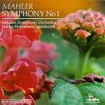
Symphony No. 1 "Titan" London Symphony Orchestra/Jascha Horenstein (Unicorn)
The First Symphony was premiered 1889with five movements and was revised 1893, with programmatic titles added to each movement and the overall title "Titan" (after a highly Romantic novel of the era by Jean Paul). Movement titles were later deleted. Most controversial for Mahler's audiences was the sardonic Funeral March, inspired by an engraving in a German children's book of animals carrying the body of a hunter in an elaborate funeral procession. The main melody is "Frère Jacques," slowed down and in a minor key, followed by modal Jewish themes. This mixture of high art and banal popular culture was revolutionary. Jascha Horenstein, though half Austrian and half Russian -- and eventually an American citizen (Jewish, he fled the Nazis and moved here in 1940) -- was to England what Bernstein was to America, the great '60s popularizer of Mahler. Here, in his second (1969) recording of the First, he leads a sensitive yet exciting rendition free of the neurotic excesses of Bernstein's first recording. Although it's my first choice, it's out of print and will run you upwards of $30 used. Both of Bruno Walter's studio recordings -- a relatively taut reading in 1954 mono with the New York Philharmonic, and a more mellow 1961 stereo recording with a smaller pick-up group -- are also well worth hearing, and the latter is much easier to find.
In the digital realm, top choice is Michael Tilson Thomas live with his San Francisco Symphony on its own label, and Klaus Tennstedt is thrilling in concert with the Chicago Symphony Orchestra (EMI).
 Symphony No. 2 "Resurrection" Elisabeth Schwarzkopf, Hilde Rössl Majdan/Philharmonia Orchestra & Chorus/Otto Klemperer (EMI Classics)
Symphony No. 2 "Resurrection" Elisabeth Schwarzkopf, Hilde Rössl Majdan/Philharmonia Orchestra & Chorus/Otto Klemperer (EMI Classics)
Mahler's Second was his first with vocals -- two soloists and a chorus. The long, instrumental first movement is the funeral rites for the hero of his "Titan" Symphony. The next two movements are somewhat rustic, but increasingly unsettling. The short "Urlicht" (Primeval Light) movement, a Wunderhorn song for mezzo-soprano, changes the mood with its profession of faith and a desire to enter Heaven. It's followed by the epic fifth and final movement, which takes off from a hymn text ("Resurrection") by Klopstock, added to considerably by Mahler. Klemperer follows the mood swings of the "Resurrection" Symphony perfectly, marvelously flexible in his phrasing and swifter than most. With fine stereo sonics and top-notch execution by all performers on a recording considered so classic that it's never out of print, there's no real need for alternative recommendations.
That said, I wouldn't want to be without Stokowski (RCA) or Walter (Columbia), and Gilbert Kaplan, a rich financier who's made conducting the “Resurrection” his avocation, has made two fine recordings (for Conifer in 1987 and for Deutsche Grammophon in 2002) that offer both excellent digital sound and a devotion to the specificity of Mahler's performance markings that's exemplary. Finally, the London Philharmonic's house label recently released a 1989 concert conducted by Klaus Tennstedt that is a deeply emotional performance. 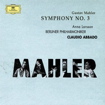
Symphony No. 3 Anna Larsson/City of Birmingham Symphony Youth Chorus/London Symphony Chorus/Berlin Philharmonic/Claudio Abbado (Deutsche Grammophon)
The Third Symphony is Mahler's longest, a six-movement ode to Nature and the World. It includes a children's choir and a soloist but is largely instrumental. Mahler's nature is not exclusively a calm pastoral scene -- it's stormy, uneasy, sometimes threatening, with mysterious rustlings and twittering, yet with rays of sunlight cutting through the shadows at times. Though as he usually did, Mahler later disavowed his programmatic explanation, originally the movements had titles: I. Summer Marches In II. What the Meadow Flowers Tell Me III. What the Creatures of the Forest Tell Me IV. What Night Tells Me V. What the Morning Bells Tell Me VI. What God Tells Me The fourth movement incorporates a song of Mahler's setting a contemplative extract from Nietzsche's Thus Spake Zarathustra, sung by contralto; the fifth movement has a cutely naïve children's chorus Made in concert at London's Royal Festival Hall in October 1999, Abbado's reading -- his second on record -- is quite dramatic, and some critics consider some parts to be over the top. But as Bernstein showed (and his recordings of this symphony, especially in 1961, are also excellent), over the top is not necessarily bad in Mahler. Abbado made this shortly before departing his post as Music Director of the Berlin Philharmonic, where he had succeeded Herbert von Karajan; his approach was similarly disciplined and precise, yet very different from Karajan's smooth, syrupy style. Karajan would never have allowed “his” orchestra to make the braying, rustic sounds Abbado evokes in the first movement, complete with village marching band. Even this far into his long and illustrious career, Abbado had continued to mature as an artist, finding greater emotional depth even as he revealed greater acuity in proportioning Mahler's massive structure.
In the fourth movement lies the difference between this and other recommendable recordings. For his 1997 recording, Simon Rattle incorporated a touch he had heard in an unreleased 1960 performance led by Berthold Goldschmidt: The solo oboe (and soon after, English horn), imitating a night bird's call, bends its pitch upward. This caused a furor when Rattle's recording was released, but it does reflect Mahler's marking in the score. And once heard, it is such a vivid and striking detail that I crave it. Abbado was the first conductor after Rattle (at least on record) to also adopt this approach, and although Rattle's recording is also excellent, it does sag a bit in spots, whereas Abbado maintains tension throughout and renders a more colorful and consistently expressive performance. Often conductors who pay such close attention to detail and highlight each episode end up with a sectionalized performance that doesn't quite hang together, but Abbado, like Horenstein, superbly balances both imperatives. For an earlier, more classic reading, Horenstein's LSO recording (by far the best of his three) used to be available separately (on Unicorn) but is now only available in a box set of all the Mahler Symphonies (Brilliant Classics). That box set is cheaper ($60) than finding a used copy of the Unicorn issue ($90 on Amazon)! Horenstein's masterful sense of proportion is vividly displayed. 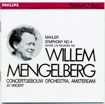
Symphony No. 4 Jo Vincent; Royal Concertgebouw Orchestra of Amsterdam; Willem Mengelberg (Philips)
Mahler's four-movement Fourth (1899-1900) is his sunniest, second-shortest, and most accessible symphony. There are some shadows in the first two movements, but the lengthy slow movement is gorgeously lyrical, and the finale is a setting for soprano of "Lied der himmlischen Freuden" (from Des Knaben Wunderhorn), a child's amusingly prosaic description of heaven. Mengelberg's 1939 live reading (in surprisingly good sound!) is a must-hear; the strings play with luscious portamento swoops before such ur-Romantic gestures were stricken from orchestras' vocabulary.
For modern, hi-fi sound, best is the San Francisco Symphony under Michael Tilson Thomas, with Laura Claycomb aptly girlish in the finale. There are many fine recordings of this, the most accessible of Mahler's symphonies; a particular favorite, because of the soloist, teams soprano Dawn Upshaw with the Cleveland Orchestra led by Christoph von Dohnanyi (London). 
Symphony No. 5 Vienna Philharmonic; Leonard Bernstein (Deutsche Grammophon)
Opening with yet another funeral march, this five-movement symphony nonetheless marked a change of direction for Mahler. It's a return to purely instrumental writing, and perhaps because of the complete absence of song-derived material the music is freer rhythmically and more contrapuntal. Yet it's the gorgeous Adagietto, supposedly written as a wordless love letter to his wife, that makes the Fifth popular with mainstream audiences. There are so many good choices in this work. Inbal (Denon) offers incredible clarity (of both orchestral sound and recording quality), complete structural integrity, and a lyrical yet unswooning Adagietto. Zander (Telarc) offers all that plus characterful playing. Abbado (Deutsche Grammophon), live with his Berliners, is also superb. Walter, in 1947 mono (Sony), must be heard by aficionados. Barbirolli (EMI) offers a heart-on-sleeve experience with the New Philharmonia (so it's better than some of his dodgy-sounding Mahler). But for the full emotional power of this work, it's gotta be Bernstein live in Vienna, 1987. His big gestures at times distort the structure (more climaxes than in a brothel!), but the overall effect is too powerful to gainsay. 
Symphony No. 6 "Tragic"
Although he wrote it during one of the happier periods of his life, Mahler called the "Tragic" "the sum of all the sufferings I have endured at the hand of life." In the last movement, the hero originally was struck down by three massive "hammer-blows of fate," which was so disturbing to the composer that he eventually deleted the final blow. It's the only one of his nine completed symphonies that ends in minor rather than major, but otherwise (unusual for Mahler) it adheres to traditional form: four movements, all instrumental, with sonata form followed in the first and last, and a slow movement and Scherzo. There's a lot of debate about correct order of the inner movements (Mahler in performance reversed them from the published order) and about whether the deleted third hammer blow should be reinstated, but my feelings on these matters are not strong enough to rule any performance out of contention on those bases alone. (However, Yoel Levi (Telarc) skipping the exposition repeat of the first movement, which drastically alters the piece's structural balance, rules out his exciting and provocative recording. Only Barbirolli gets away with no repeat, by taking such a funereal tempo that his first movement's just seconds shorter than Bernstein's with the repeat!) Sanderling's 20-bit digital rendition with the St. Petersburg Philharmonic on the Italian label RS came out of nowhere in 1995 and impressed not only aficionados but also my younger self who hadn't previously found Mahler particularly interesting. This recording changed my mind. In one way the surprising thing about this recording is that it even exists: Sanderling's never recorded any other Mahler that I've noticed, and nowadays anyone conducting Mahler usually goes for a cycle. But this one-off impressed both sonically and interpretively. It's out of print, and even finding a used copy is difficult, so hooray for iTunes. That said, MP3 sound will not reveal the full glories of this recording, which displays a level of detail beyond any other along with a killer combination of power and refinement. In the first movement, Sanderling's on the slow side, but I can only tell that by the timing, because it sounds taut and urgent and the notes sparkle with energy. His whiplash Scherzo is a continued harrying of the hero, every bit of optimism countered by a touch of terror, and he's not afraid to let the brass bray unbeautifully (yet precisely). He moves through the Andante with relative alacrity -- a true Andante, not the near-Adagio of Horenstein and Tennstedt -- but still creates enough tenderness to offer the necessary contrast to what's gone before and what's to come. And his finale pays heed to Mahler's structural organization and maintains proportion in emotional terms as well rather than crushing the hero too quickly. Tilson Thomas's shatteringly dark Sixth (also digital) is worth hearing, but it's almost too bleak. The main alternative is Bernstein. It's no surprise that hyper-emotional Lenny does so well with this agonized autobiographical work. I prefer his fresher approach in his first recording, for Columbia in '67, which crackles with intensity. The tempo indication for the first movement, Allegro energico, ma non troppo (energetically rapid, but not too fast) has long provoked debate. The movement often seems to be aiming at a funeral march effect, which would seem to contradict the Allegro; some conductors (especially Barbirolli, as noted above) have taken it very slowly to emphasize the funereal aspect. Others have most honored the energico indication, most extremely Bernstein at a maniacally fast tempo. In the finale, Bernstein doesn't so much balance the contrasting moods as indulge in matching manic-depressive mood swings, with a dramatically crushing conclusion. But as thrilling and cathartic as Bernstein's interpretation is, Sanderling offers a more symphonically satisfying experience.
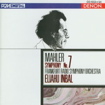 Symphony No. 7 Frankfurt Radio Symphony Orchestra/Eliahu Inbal (Denon)
Symphony No. 7 Frankfurt Radio Symphony Orchestra/Eliahu Inbal (Denon)
The Seventh is in some ways Mahler's most original work. The harmonies are daringly ambiguous at times, and the finale anticipates the theories of John Cage as its highly independent lines conjure the unregimented chaos of natural life. The five movements are bilaterally symmetrical, with the middle of the work consisting of three relatively sparely orchestrated movements, two titled "Night Music" surrounding an eerie Scherzo -- dream-like intermezzi. This is a work where I feel a less interventionist approach works best; it's already so startling and weird that any further distortion overdoes it. The startling transparency of Inbal's performance highlights the music's strangeness and imagination, sounding more Modernist than Romantic. Bernstein (either one) is more dramatic, or perhaps grotesque, depending on one's tastes, but certainly should be heard.
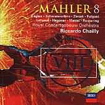 Symphony No. 8 "Symphony of a Thousand" Jan-Hendrik Rootering, Peter Mattei, Jane Eaglen, Anne Schwanewilms, Ruth Ziesak, Sara Fulgoni, Anna Laarson, Ben Heppner; Prague Philharmonic Chorus, Netherlands Radio Chorus; Royal Concertgebouw Orchestra; Riccardo Chailly (Decca)
Symphony No. 8 "Symphony of a Thousand" Jan-Hendrik Rootering, Peter Mattei, Jane Eaglen, Anne Schwanewilms, Ruth Ziesak, Sara Fulgoni, Anna Laarson, Ben Heppner; Prague Philharmonic Chorus, Netherlands Radio Chorus; Royal Concertgebouw Orchestra; Riccardo Chailly (Decca)
The monumental "Symphony of a Thousand" is in two movements, Mahler's adaptation of a ninth-century Christian hymn and the final scene of Goethe's Faust. It's hard to effectively convey music that seems to consist of a nearly continuous series of climaxes (which, frankly, can become tedious; this is my least favorite Mahler), and with so many soloists, casting is never perfect. There are some magnificent performances of older vintage by Jascha Horenstein and Leopold Stokowski, and arguably Bernstein as well, but in this densely textured work, modern sound is a great asset. For digital sound and a less orgiastic approach than Bernstein, plus better soloists, I lean towards Chailly. He makes the structure hang together better than most, without stinting on the drama -- and his choirs are excellent. Mostly, though, I skip this symphony; the Faust part is too over the top even by Mahler's standards.
 Das Lied von der Erde Christa Ludwig; Fritz Wunderlich; Philharmonia O & Chorus; Otto Klemperer (EMI) Murray Dickie; Dietrich Fischer-Dieskau; Philharmonia Orchestra; Paul Kletzki (EMI)
Das Lied von der Erde Christa Ludwig; Fritz Wunderlich; Philharmonia O & Chorus; Otto Klemperer (EMI) Murray Dickie; Dietrich Fischer-Dieskau; Philharmonia Orchestra; Paul Kletzki (EMI)
Mahler wrote the six-movement song-cycle symphony Das Lied von der Erde (The Song of the Earth) in 1907-08 after learning of his heart problem. (The not particularly plausible story goes that he considered it a symphony but superstitiously dared not number it as his Ninth because Beethoven, Schubert, and Bruckner had not made it past that milestone.) The nostalgic yet angst-ridden texts are from German poet Hans Bethge's collection The Chinese Flute, paraphrases of eighth-century Chinese poems. Mahler chose some of the most poignant ones; the movements are "The Drinking Song of Earthly Woe," "The Lonely One in Autumn," "Of Youth, "Of Beauty," "The Drunken One in Springtime," and the half-hour-long "The Farewell," the latter combining several poems. It's a meditation on -- and wailing against, but acceptance of -- aging and mortality against the backdrop of the eternal cycles of nature. There are two ways of presenting it: with alto and tenor vocalists, which is standard and offers male-female contrast, and with baritone and tenor, which seems to fit the masculine poet's words better. I present an option for each. Klemperer first conducted Das Lied in Russia in 1924, and programmed it as often as he could through the long period when Mahler's music was disdained by the public and critics alike. The sessions for this classic recording were spread out over 1964 and '66 due to the dissolution and reconstitution of the Philharmonia Orchestra, but Klemperer's steely vision of the work makes it cohere. Not for him the emotional effulgence and abandon of Leonard Bernstein; Klemperer is more stoic -- both reflect sides of Mahler's personality, of course. Klemperer has superb soloists: ill-fated tenor Fritz Wunderlich, who died before the LP was released, and beloved mezzo-soprano Christa Ludwig. Wunderlich is by turns heroic and frenzied in the high-pitched emotions of the mighty opening movement, while Ludwig's restraint in "Der Abschied" makes it all the more shattering. Klemperer draws fine balance and clarity from the orchestra in a score that, by Mahlerian standards, is colorful but often sparely orchestrated, and the playing is exquisite. For the hot male-on-male Das Lied, choosing between baritone Fischer-Dieskau's two recordings is tough. On his Decca recording, he's accompanied by Bernstein's direction, a plus, but the tenor, James King, is sometimes rather hectoring in the tone of his delivery (though at least his heldentenor's able to rise above the orchestra with relative ease). I prefer the less famed Murray Dickie as Fischer-Dieskau's tenor foil, but some find Paul Kletzki's conducting less distinguished than Bernstein. However, Kletzki was a fine Mahlerian (his Fourth is exemplary), his approach is just more beauty-oriented than Bernstein's. As such, and since Lenny and his melodramatic approach are so well represented already, I am all the more eager to opt for a more lyrical alternative.
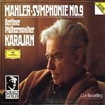 Symphony No. 9 Berlin Philharmonic Orchestra; Herbert von Karajan (Deutsche Grammophon)
Symphony No. 9 Berlin Philharmonic Orchestra; Herbert von Karajan (Deutsche Grammophon)
Written after Mahler had been diagnosed with a life-threatening heart disease, his Ninth Symphony has been widely interpreted as reflecting that knowledge -- but of course there are many reactions produced by the prospect of death. In many ways the Ninth stands alone among Mahler’s symphonies. With no particular programmatic agenda, no chorus or vocalists, it has a purity and directness of expression that, although extremely moving and poignant, avoids the purple effects and over-ripeness that some of his other symphonies could be accused of. It wouldn’t be Mahler without a healthy dose of emotional strife, but the final movement is so serene as to seem utterly heavenly. The aging Karajan could have been contemplating his mortality when he gave this expansive concert performance. The lengthy first movement sometimes seems like a meditation on the mysteries, terrors and -- yes -- consolations of death. The cries of the muted brass are poignant, and a bit afraid; somewhat assuaged by the occasional reappearance of a beautiful melody that seems to promise relief from earthly cares. But the nervous twitterings of the winds, and the lengthy sections of quiet foreboding display an underlying unease. But the lyrical music that eventually triumphs is delivered with all the considerable polished beauty for which Karajan had long trained his orchestra. Other conductors with other agendas play the dances of the second movement with more authentic pungency, but Karajan prefers idealized, supremely beautiful dances that transcend earthly dancing, instead inhabiting a Platonic realm (or, at Tempo III, the dance music of the spheres), though he does still allow a bit of Mahler's wit to shine through, albeit more sophisticated than bumptious, in the three Tempo II sections. The subsequent Rondo Burleske is played abstractly, a structural counterbalance rather than an authentic psychological event, but nonetheless effective. This is forgivable because of what follows. The Adagio finale, among the most gorgeous in Mahler's oeuvre, displays an acceptance of the inevitability of death and looks forward to the eternal peace the religious Mahler hoped for. Karajan (and the solo violinist!) delivers this full of yearning hope, a more positive and uplifting reading than the studio version he'd made two years before. The luxuriant yet cleanly defined sound highlights the absolute beauty of the transcendent performance. It's not the definitive interpretation by any means, though it is certainly impressive how deeply moving it is. But there are other ways to play the piece that need to be heard as well.
Bruno Walter's premiere recording with the Vienna Philharmonic in 1938 (EMI) retains a special magic both historically and, despite flaws in the orchestra's playing, in its authentically Romantic sound -- a sound, one could say, closely related to its style under Mahler himself when he led it during his unhappy and strife-ridden tenure. Walter's stereo 1961 rendition is more easily enjoyed despite the loss of atmosphere, but is also less than ideal because of the relative thinness of the somewhat small pickup orchestra and the space in which it recorded, though the nobility and tensile strength of his interpretation are undimmed. The earthiness and macabre elements missing from Karajan's inner movements are found in spades in Mahler specialist Benjamin Zander's Telarc recording. Simon Rattle's performance with the Vienna Phil. has eccentricities but is beautiful and emotionally effective (and more compelling than his Berlin remake). The sensuality of Bernstein's Concertgebouw version is bizarre and his old NY Phil. issue doesn't reach the heights he's aiming for, but a valedictory effort with the Berliners conveys electric tautness across its slowly measured breadth, a more neurotic (and thus, to some tastes, more Mahlerian) cousin to Karajan's.
And Karel Ančerl with the Czech Phil. (Supraphon) offers yet another approach, a much more urgent interpretation with considerable and appropriate energy in the dances and the Rondo Burleske. The orchestra's refulgent tones take on a consoling sweetness in the middle of the finale before the resplendent brass deliver a triumphant climax; the sweetness returns for the gentle ending.
 Symphony No. 10 Berlin Philharmonic; Simon Rattle (EMI)
Symphony No. 10 Berlin Philharmonic; Simon Rattle (EMI)
Mahler died of a blood disease before he put the finishing touches on his Symphony No. 10 in F minor, but Mahler's Tenth is not unfinished in the sense of Schubert's Eighth or Bruckner's Ninth. It was sketched out in its entirety, with the lengthy opening Adagio basically completely scored (many conductors perform it by itself) and the short Purgatorio movement's first 28 measures scored. Deryck Cooke, working with composer Berthold Goldschmidt, prepared a performing edition premiered in 1964 and revised over the next decade. The full work is in five movements, with the sort of roughly bilateral symmetry as in the Seventh. The second and fourth movements are Scherzos, the second jagged and full of then-radical frequent meter shifts, the fourth an agitated outburst of tortured angst that has been aptly characterized as "demonic" (Cooke's use of xylophone is an inspired touch). The intervening Purgatorio alternates between mysterious, nearly ethereal quiet and unsettling eruptions. The long, slow Finale at first continues the disturbing ending of the second Scherzo, but gradually morphs into an ecstatic serenity similar to that of the opening yet somehow more triumphant in tone. Competing completions have appeared from other sources, but Cooke's remains the most frequently heard. Sir Simon Rattle returned to Mahler's Tenth two decades after recording it to considerable acclaim in 1980 with the Bournemouth Symphony Orchestra. In the interim he had worked with Cooke and his collaborators on incorporating orchestration changes that Rattle had tested and found successful. The newer recording, made from two Berlin Philharmonic concerts in September 1999, showed that he had not drastically changed his overall view of the piece. Whether for interpretive reasons or because of the difference between studio and concert-hall acoustics, he is a tiny bit slower in the first, fourth, and fifth movements and basically the same in the other two; the total difference (in actual playing time, not track timings) is just one minute and 35 seconds -- hardly significant in an hour-and-a-quarter work. The major differences are that -- unsurprisingly -- the Berliners have lusher strings and brass than the Bournemouth SO (though the latter is a fine group) and the recorded sound of the new release offers more "air" around the orchestra (the Bournemouth recording is fairly close and dry). Besides himself, Rattle's main competition in the Cooke realization is Riccardo Chailly's 1986 recording. Rattle is more controlled, faster, and with better sound, and although Chailly brings more passion to the large outer movements, Rattle's approach works better in the inner movements. Both are highly recommendable.
Song Cycles
Given how crucially inspirational to the composer Mahler's lieder were within his output, a haphazard accumulation of them as filler on symphony recordings will not suffice. Kindertotenlieder (Songs on the Death of Children), 5 Rückertlieder (five songs setting poems by Friedrich Rückert), Lieder eines fahrenden Gesellen (Songs of a Wayfarer) are fairly simply dealt with. 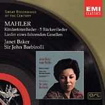
Janet Baker; Hallé Orchestra/New Philharmonia Orchestra; Sir John Barbirolli (EMI)
The obvious recommendation -- and four decades on, it still does not disappoint. It's not just that it has all three cycles, though that does make it especially tempting to less obsessive collectors with limited shelf space. Estimable mezzo-soprano Baker shows keen understanding of the songs and delivers them in silken tone and tender phrasing over Barbirolli's lovingly crafted accompaniments. There are two very special performances additionally worth tracking down. First, the 1958 Kindertotenlieder and Lieder eines fahrenden Gesellen RCA Living Stereo recordings that kick-started contralto Maureen Forrester's recording career. The power of Forrester's voice is stunning, and she is accompanied by a vastly better orchestra, the Boston Symphony Orchestra conducted by Charles Munch, in superb sonics. Alas, as far as I know it's only been on CD in a Japanese limited edition that sold out. And speaking of powerful voices, Marilyn Horne's Decca recordings of Kindertotenlieder/Rückertlieder/Lieder eines fahrenden Gesellen have been reissued inexpensively on Decca's Eloquence line and are easily found (on iTunest). 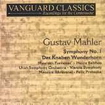
Des Knaben Wunderhorn Maureen Forrester; Heinz Rehfuss; Vienna State Opera Orchestra; Felix Prohaska (Vanguard)
This is a somewhat elastically defined cycle. Mahler set many songs from the collection of poetry of this title, not all orchestrated. The core group is twelve orchestrated songs, but some recordings add a Knabenhorn song or two extracted from symphonies. For me there is one obvious choice: Forrester accompanied by the Vienna Philharmonic under its other name. (This is currently available paired with a decent First Symphony by Maurice Abravanel, a most perceptive Mahler conductor not granted an orchestra worthy of his talents. Since it's two-for-one pricing, that's not a problem.) Apologies for not getting into the voice-and-piano songs; they just aren't as important as his orchestral music.
